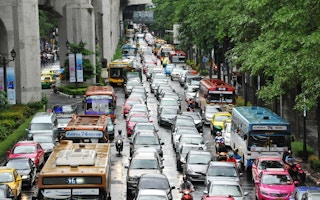Climate action often focuses on energy and industrial activity, but the transport sector must be included to keep global warming below the dangerous two-degree scenario. Transport is responsible for 22 percent of energy-related greenhouse gas (GHG) emissions worldwide, and its emissions are increasing at a faster rate than any other sectors.
To continue reading, subscribe to Eco‑Business.
There's something for everyone. We offer a range of subscription plans.
- Access our stories and receive our Insights Weekly newsletter with the free EB Member plan.
- Unlock unlimited access to our content and archive with EB Circle.
- Publish your content with EB Premium.
On top of that, transport infrastructure lasts for decades, so the decisions local and national governments make today will have long-lasting impacts on urban development and form, as well as climate. We know that we need to avoid, shift, and improve – avoid the need for motorized travel, shift trips to the most sustainable mode, and improve existing technologies and systems. But the need remains for a strong political signal to shift market forces toward a sustainable, low-carbon development pathway.
Next week at the UN Climate Summit in New York City, leaders from business, national government, and cities will convene to discuss bold actions to address climate change in various sectors, including transport. And while climate change is an international challenge, climate action in the transport sector is proven to create significant and immediate development benefits at the national and local levels.
Climate action in the transport sector is an important opportunity to demonstrate how the sustainable development agenda and the climate agenda can be brought together to support the growth of emerging economies.
Why should world leaders care about transport?
Implementing low-carbon transport options can create multiple economic and social development benefits, in addition to reducing emissions. These local benefits include improved air quality, safer streets, and poverty alleviation.
Outdoor air pollution was associated with 3.7 million premature deaths in 2012, and fuel combustion in motor vehicles is responsible for up to 75 percent of urban air pollution. Improving fuel technologies and shifting passengers to more sustainable modes like public transport, walking, and bicycling can both improve air quality and lower carbon emissions.
Beijing, for example, heavily restricted the use of motor vehicles when it hosted the 2008 Olympic Games, with residents instead relying on bicycling and public transport. These efforts not only decreased CO2 emissions by anywhere from 26,500 to 106,000 tons each day during the event, but also yielded a 50 percent reduction in asthma-related doctor visits and a 31 percent reduction in PM2.5 particulate matter, a main culprit of respiratory illnesses.
Reducing emissions in the urban transport sector can also create attractive jobs and strengthen local economies. Consider Bogotá, Colombia, where the city’s TransMilenio bus rapid transit (BRT) system has reduced transport emissions by almost 250,000 tons of CO2 each year since 2000 while contributing to a net gain of 1,900 to 2,900 permanent jobs.
How can world leaders achieve climate action in transport?
“
Implementing low-carbon transport options can create multiple economic and social development benefits, in addition to reducing emissions. These local benefits include improved air quality, safer streets, and poverty alleviation.
Even though proven solutions exist to curb transport sector emissions, they require a fundamental shift in policy and financial support to favor sustainable, low-carbon transport projects. Public sector funding priorities have historically expanded infrastructure benefiting personal vehicles, while the private sector has invested in transport systems. Global transport investment currently averages between US$1.4 and US$2.1 trillion each year, but the majority of these funds go toward “brown,” carbon-intensive transport projects.
International climate finance is available to fund “green” projects – estimates of global climate finance covering all sectors total $359 billion. Public climate funding sources only comprise approximately one-tenth of one percent of total global investment in the transport sector. In order to make climate finance truly transformational, these funds must be increased and used more efficiently.
Leaders must be open to policies that turn the tables on urban sprawl by routing planning away from the unsustainable, auto-centric development already emblematic of many parts of the developed world. One such tool is transit-oriented development (TOD), which policymakers can use to combine low carbon transport systems with sustainable land use development.
Mexico, for example, promotes compact urban communities and combats the country’s history of sprawl through financial incentives for infrastructure development in the urban core rather than the suburban periphery. This kind of policy support, especially through land use, is necessary to accelerate the shift toward “green,” sustainable transport projects.
Setting the stage for bold action in the transport sector
Next week’s Climate Summit is a critical step in a series of events that will determine how the world confronts climate change, culminating with the UN’s 21st session of the Conference of the Parties (COP21) in Paris in December 2015.
Public and private sector leaders are expected to take “bold action in New York to reduce transport-related greenhouse gas emissions by expanding the use of public transportation, greater use of more efficient rail transportation, and the accelerated introduction of urban electric transport” with announcements on:
- The Urban Electric Mobility Vehicles Initiative (UEMI)
- The International Union of Railways (UIC) Low-Carbon Sustainable Rail Transport Challenge
- The International Association of Public Transport (UITP) Declaration on Climate Leadership
In addition to official transport discussions on the day of the Summit, experts from the WRI Ross Center for Sustainable Cities and its EMBARQ initiative for sustainable transport will participate in side events focused on the transport sector’s evolving role in the climate agenda and the innovative actions cities have taken to become more sustainable.
Two sessions during the official Summit proceedings will address how to achieve this path to low-carbon, sustainable development – focusing on cities and transport respectively. We expect Climate Summit leaders to recognize the urgent need to make a long-term commitment to develop policies and shift funding toward sustainable, low-carbon transport alternatives. Together, they can reduce emissions, achieve development goals, and support economic prosperity.
Benoit Lefevre is the Director of Energy & Climate for EMBARQ, the sustainable transport program of WRI. Angela Enriquez is the Program Coordinator/Research Analyst for the Climate and Energy Program and EMBARQ. This post originally appeared on the World Resources Institute Insights blog.











